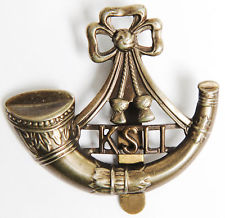Personal Details
Born: In 1891 in Whitchurch, Shropshire.
Family: He was one of nine children born to Patrick Boyle, a labourer in an iron foundry, and his wife Margaret (nee O`Neill). His father died in about 1897. By the time of the 1911 Census only four of the children were still alive. No marriage can be found for James.
Residence: All records show that James lived at 29 Yardington,Whitchurch, Shropshire for most of his life. Though no evidence of an address for him can be found after 1919.
Employment: On the 1911 Census his occupation is that of a labourer in an iron foundry. No other occupation can be found for him after that.
Died: 1929 in Whitchurch,Shropshire, aged 37.
Military Details
Regiment: King’s Shropshire Light Infantry
Rank: Private
Service Number: 31163 (previously T4/ 37252)
Date of Enlistment: 19 November 1915
Date of Discharge: 10 January 1919
Reason for Discharge: Demobilisation
Other Information: James’ older brother, John, served in The Royal Engineers during WW1. He died of wounds in France on 16 September 1917, aged 35, and is commemorated on the Whitchurch Town Memorial.
James was awarded the Campaign Medals (British War Medal, and Victory Medal).

The British War Medal (also known as 'Squeak') was a silver or bronze medal awarded to officers and men of the British and Imperial Forces who either entered a theatre of war or entered service overseas between 5th August 1914 and 11th November 1918 inclusive. This was later extended to services in Russia, Siberia and some other areas in 1919 and 1920. Approximately 6.5 million British War Medals were issued. Approximately 6.4 million of these were the silver versions of this medal. Around 110,000 of a bronze version were issued mainly to Chinese, Maltese and Indian Labour Corps. The front (obv or obverse) of the medal depicts the head of George V. The recipient's service number, rank, name and unit was impressed on the rim.
The Allied Victory Medal (also known as 'Wilfred') was issued by each of the allies. It was decided that each of the allies should each issue their own bronze victory medal with a similar design, similar equivalent wording and identical ribbon. The British medal was designed by W. McMillan. The front depicts a winged classical figure representing victory. Approximately 5.7 million victory medals were issued. Interestingly, eligibility for this medal was more restrictive and not everyone who received the British War Medal ('Squeak') also received the Victory Medal ('Wilfred'). However, in general, all recipients of 'Wilfred' also received 'Squeak' and all recipients of The 1914 Star or The 1914/1915 Star (also known as 'Pip') also received both 'Squeak' and 'Wilfred'. The recipient's service number, rank, name and unit was impressed on the rim.

